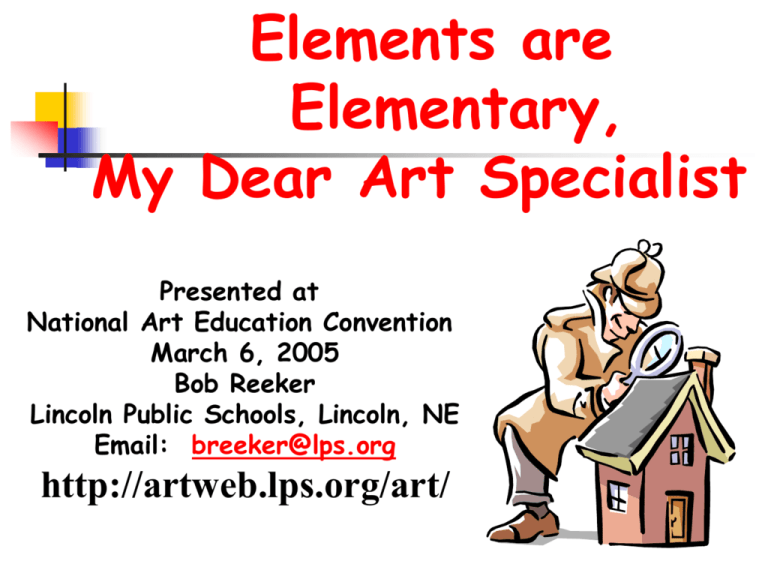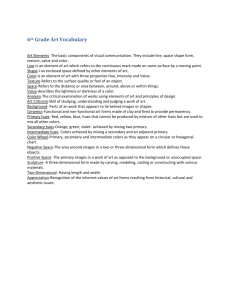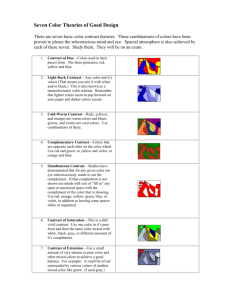Neutral colors
advertisement

Elements are Elementary, My Dear Art Specialist Presented at National Art Education Convention March 6, 2005 Bob Reeker Lincoln Public Schools, Lincoln, NE Email: breeker@lps.org http://artweb.lps.org/art/ Lincoln, Nebraska located in the southest corner of the state state capitol of Nebraska 225,000+ population University of Nebraska-Lincoln located in Lincoln Lincoln Public Schools 31,000+ students 5,000+ staff 52 buildings (36 elementary, 10 m.s., 6 h.s.) Art specialists in all schools except 9 elementaries Lincoln Public Schools 7 Core Abilities 1.The Creative Process 2.Connect with art 3.Express ideas through art 4.Know language of art 5.Create art 6.Live with art 7.Talk about art Line Repetition Sh pe a Balan Balance ce ART Color C olor Lincoln Public Schools focuses on 7 Elements of Design (taken from “Crystal Production” posters)… LET’S EXPLORE THESE… 7 Elements of Design 7 Elements of Design 7 Elements of Design 7 Elements of Design 7 Elements of Design 7 Elements of Design 7 Elements of Design Daily Art “Think About” Color is an Element (tool) of Design The three primary colors can not be made by mixing any other colors together. Red, Blue, and Yellow Primary colors make all of the other colors on the color wheel Place the colors equally on the color wheel. Secondary Colors : Violet, Orange, and Green Place the colors equally on the color wheel. Secondary colors are mixed by combining two primary colors together. Warm colors Cool colors. Neutral colors: Black, White, Gray, and Brown Neutral colors: Black, White, Gray, and Brown Black can be mixed by combining all the colors. Neutral colors: Black, White, Gray, and Brown Brown is mixed by combining two compliments. Neutral Colors White + Black + = Gray = A tint is made by mixing white to any color. A shade is made by mixing black with any color. The year starts with Color for Kindergarten… 1.White Rabbit’s Color Book and a color sheet. Next… 2. Color mixing using tempera paints with food color mixing on overhead… Finally… 3. Oil pastels added to color mixing with color paddle demonstration on overhead. Be sure to have a color wheel on your wall! Daily Art “Think About” Value is an Element (tool) of Design In art, value refers to: 1.light and dark 2.how much you respect a person 3. the worth of money Values are shown on a gray scale or value scale. Value is also used in color. What happens on the gray scale if white is on one end and red is on the other? This is what happens on the gray scale when white is on one end and red is on the other. We also use 7 Principles of Design From Crystal. Use of a sketchpad, grades 3-5 for direct teaching Planning to Teach the Elements of Design Labels on Elements and Principles Posters Assessment Assessment Assessment blue = line yellow = color red = value Assessment Time for Questions, Answers, and Sharing… Thank you for coming today. I hope you enjoyed the presentation. Contact: breeker@lps.org http://artweb.lps.org/art/






